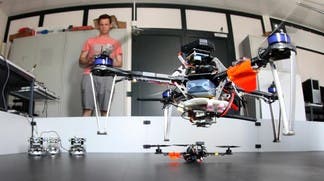In Philip K. Dick’s novels, a common denominator is the complete autonomy of the surrounding technology. The human characters often interact with their toaster which knows what kind of grill cheese they prefer and even makes small talk, to the extent of exasperation from the human counterpart. A more palpable side to reality is the transportation – most of the time in Dick’s novels, the characters prance from one corner of the globe to another by an aerial vehicle, which simply gets you to your destination fast and easy without any kind of human intervention – you just need to sit tight, and maybe put up with your aerovehicle’s chattering.

Now, three EPFL laboratories are working closely together as part of a joint effort to design a completely autonomous flight system for airplanes that is safe and reliable, and happy to put pilots out of work. Now, you might say that this has already been implemented for UAVs; hold your horses though. When carrying people, you’re in a whole different ball game.
For one, this is an immense technological challenge which requires interdisciplinary expertise, which is why three extremely well staffed laboratories from one of the best tech schools in the world have been enlisted for the project. These are the Real-Time Coordination and Distributed Interaction Systems Group (REACT), which is working on predicting trajectories and in-flight collision avoidance; the Computer Vision Laboratory (CVLab), which has the job of outfitting the aircraft with a veritable visual intelligence system; the Distributed Intelligent Systems and Algorithms Laboratory (DISAL), which will test algorithms on small, lightweight flying robots.
Yes, all available resources will be called out for this one, and, again, this is a lot harder than it may seem. The REACT team, for instance, which has a long history with unmanned vehicles will try to develop a system which makes use of any positioning and sensing device inside an airplane, whether it’s GPS, ground-based radar, cameras, infrared cameras etc, and develop a position and trajectory algorithm based on the data fed by these devices.
This will came in handy for DISAL which in charge of developing an algorithm that will help communicate between airplanes. “We will work on integrating trajectory prediction, avoidance, stability, vision, and data-exchange algorithms developed by various laboratories, and see how to get them working together in real time,” explains laboratory director Alcherio Martinoli.
CVLab will work with high definition cameras, designed to recognize objects. “What seems to be a simple task for the human eye is incredibly complex to reproduce technically,” explains CVLab scientist Vincent Lepetit . “The main difficulty lies in the enormous amount of information that has to be processed; each image is made up of several hundred thousand pixels.”
Apparently, all the three labs have been called upon for the project by Honeywell, a huge industry player in the oil and mechanical engineering scene, but also in the aerospace sector.
“These new technologies will not only help us improve general flight safety, for example by providing better autopilot systems, but they will certainly also have other uses in automating everyday life,” says George Papageorgiou, director of the Aerospace Advanced Technology Europe System Engineering & Applications Department at Honeywell.
In the first instance, according to Honeywell officials, such a system will be first used for small airplanes or drones in non-military applications, such as forest fire surveillance or monitoring access to industrial sites and borders.
Would you fly on complete autopilot? Discuss below in the comment section.


